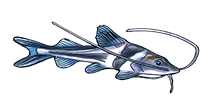https://doi.org/10.1111/ahe.70026
https://onlinelibrary.wiley.com/doi/ful ... /ahe.70026
ABSTRACT
The current study aims to describe the macroscopic, histological and histochemical features of the digestive tract of omnivorous fish species Panga Pangasius hypophthalmus—which derives from Southeast Asian watersheds—with emphasis on secretory cell types and their histochemical reactions. Results have evidenced that the anatomical organisation of the digestive tract in the coelomic cavity of the investigated species is similar to that of other omnivorous teleosts, except for a pneumatic duct linking the distal portion of their oesophagus to their swim bladder. It is worth highlighting that both the oesophagus and the stomach have well-developed histological layers and that the stomach has a saccular shape and is highly distensible to ensure longer food storage time. Intestinal loops are convoluted and present well-developed mucosal folds with varying widths, heights and thicknesses; these features increase the nutrient absorption surface. The digestive tract presented histological and histochemical features similar to those of other siluriform fish that show the same feeding habits and secretory cells throughout the digestive tract, whose acid and neutral secretions guarantee the functionality of digestive processes.




